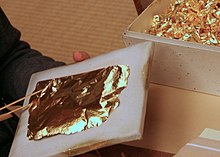Metal leaf





A metal leaf, also called composition leaf or schlagmetal, is a thin foil used for decoration. Metal leaves can come in many different shades. Some metal leaves may look like gold leaf but does not contain any real gold. This type of metal leaf is often referred to as imitation leaf.
Metal leaves are usually made of gold (including many alloys), silver, copper, aluminium, brass (sometimes called "Dutch metal" typically 85% Copper and 15% zinc) or palladium, sometimes also platinum.
Vark is a type of silver leaf used for decoration in Indian cuisine.
Goldbeating, the technique of producing metal leaves, has been known for more than 5,000 years.
See also
References
